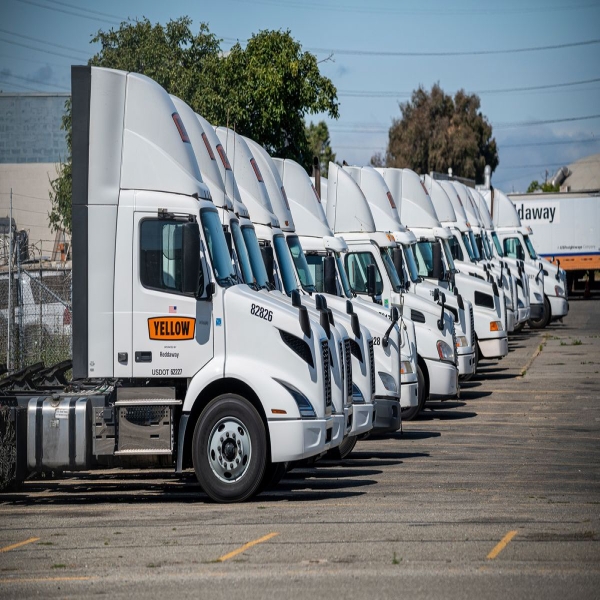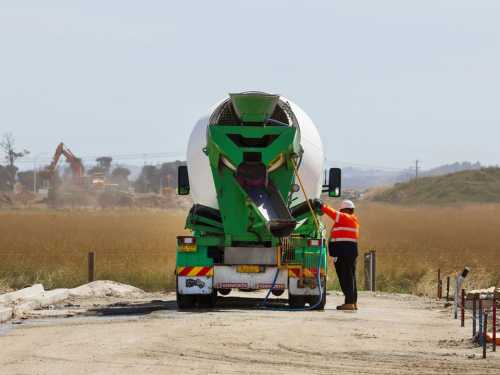The freight trucking company Yellow struggled for years. It’s blaming its union anyway.

Whizy Kim is a reporter covering how the world’s wealthiest people wield influence, including the policies and cultural norms they help forge. Before joining Vox, she was a senior writer at Refinery29.
Stories of supply chain snarls have been making headlines since the start of the pandemic. They’ve caused delays, driven up the price of goods, and led to high-profile confrontations between the industry and its labor unions. Now, the shutdown of a major US freight trucking giant is the latest sign of the shipping sector’s long-haul troubles.
Yellow, a 99-year-old trucking company based in Nashville, Tennessee, filed for bankruptcy this week, just a few years after it received a $700 million government loan through the pandemic-relief CARES Act under President Trump, and months into heated contract negotiations with the Teamsters, the union representing the majority of Yellow’s workforce. The bankruptcy has inflamed a blame game around why the once-thriving trucking company buckled, with some politicians finding fault with government bailouts that merely delay the inevitable doom for struggling companies, and others — including Yellow — pointing the finger at organized labor.
Yellow’s downfall raises many questions about what it means for its 30,000 employees, for taxpayers, and for consumers who have already watched the price of everyday items climb amid supply chain disruptions. Sorting out its assets and dealing with freight that remains to be delivered will take some time, resulting in tie-ups. Some supply chain clients expected this and had already left for more expensive competitors — meaning consumer prices could rise.
While the closure of one shipping industry leader doesn’t mean the average consumer is suddenly going to see emptier store shelves, Yellow’s bankruptcy is a sign that the industry’s woes aren’t going away anytime soon: It’s a hyper-competitive landscape with high operational costs, including expensive fuel and pay for an army of human drivers. Trucking needs a hefty workforce to avoid disruptions to its always-on-the-move business, yet for years it has been beleaguered by a driver shortage.
With Yellow’s shuttering, consumers could eventually see the ripple effects in what it costs to buy items and have them delivered — even more than they already have — as the push-and-pull between freight companies trying to turn a profit and workers asking to be paid adequately for their labor plays out again and again.
Yellow’s fraught freight history
Yellow, which was formerly known as YRC Freight, was one of the largest “less-than-load” (LTL) transport companies in the US. These are businesses that deliver smaller quantities of freight, somewhere between full-trailer truckloads and individual parcel shipping (like the kind that carries your Amazon package). Yellow made up about 9 percent of the LTL market, according to the industry publication FreightWaves. It was the third-largest LTL company in the nation — other top LTL shippers include FedEx Freight, XPO, and Old Dominion Freight Line — delivering industrial, commercial, and retail goods across a wide range of sectors, including the defense and aerospace industries, automotive manufacturers, oil and gas companies, and health care, according to its website.
Its size and history is partly why its Chapter 11 bankruptcy filing is big news — yet the bankruptcy may not have come as a surprise to anyone who’s been watching the logistics industry, or Yellow specifically, over the past decade and a half. The company made a few expensive acquisitions in the early 2000s; then the 2008 financial crisis hit and customers fled, and it reported a net loss of nearly $1 billion that year. Yellow almost filed for bankruptcy the following year, avoiding it only after its employees took pay cuts. It considered bankruptcy again in 2014 and in 2020, according to the Wall Street Journal.
“There aren’t too many companies out there that have got a 99-year history and 30,000 workers,” says Ryan Patel, a senior fellow at the Claremont Graduate University’s Drucker School of Management with expertise in challenges facing the global supply chain. “That less-than-truckload concept was what they were initially the leaders of, but over time, there were a lot more players coming into it.”
In recent months, particularly during union contract negotiations, there were signs that Yellow was on the verge of buckling again. Its creditors number over 100,000 and include the likes of Amazon, according to a New York Times report. It failed to make recent payments into the employee pension fund, owing about $50 million — which almost resulted in a strike, before the union agreed to give the company more time to make the payments. The looming strike set off alarm bells, and Yellow’s delivery volume fell 80 percent as customers fled. Then, last week, the Teamsters were notified that the company would be shutting down.
Much of the public discussion around Yellow’s shutdown has centered not on the bankruptcy itself, but on the $700 million loan the federal government handed it in 2020 — a bailout that has drawn scrutiny for years. A recent Congressional Oversight Commission report found that Yellow didn’t qualify for the CARES Act loan as a company vital to US national security interests, as the legislation stated — Yellow often delivered to military bases around the country, but the congressional committee’s final report determined that other freight trucking companies could have provided those delivery services. In fact, almost all of the money set aside in the CARES Act for businesses important to “national security” went to Yellow. It also should have been ineligible because it was already in poor financial condition prior to the pandemic.
At the time of the bankruptcy filing, it had repaid just $230 of the loan’s principal. The loan came with a low interest rate in exchange for a near 30 percent equity stake for the US Treasury. Yellow says it intends to repay the CARES Act loan in full.
How Yellow’s labor disputes escalated
Despite the lifelines it had been thrown, Yellow remained in grim financial straits. As debt mounted and Yellow became increasingly cash-strapped, labor negotiations grew tense. About 22,000 of its 30,000 total workforce are union members. In recent months, the company began bargaining for its next contract, with the current one set to expire in March 2024, but the two sides stood far apart on key issues, including an $11-per-hour pay increase over the next five years, pension fund payments, and some operational changes at the company.
In June, Yellow filed a lawsuit against the union for blocking the restructure of the company, claiming that its obstruction had cost the company $137 million. The Teamsters denied the claim. “After decades of gross mismanagement, Yellow blew through a $700 million bailout from the federal government, and now it wants workers to foot the bill,” Teamsters general president Sean O’Brien said in a statement. The union, for its part, has sued Yellow, alleging it failed to provide the required notice for mass layoffs.
Yellow CEO Darren Hawkins, whom the company paid a total of $1.27 million last year according to public filings, was also quick to blame the Teamsters during the bankruptcy announcement, saying in a statement that “all workers and employers should take note of our experience” with the Teamsters and “worry.” “A company has the right to manage its own operations, but as we have experienced, [union] leadership was able to halt our business plan, literally driving our company out of business, despite every effort to work with them,” he continued.
Labor has long been a major presence in the logistics industry — there are about 340,000 union UPS workers, for example — but unionized drivers and dock workers have become less common since the deregulation of the trucking industry in the 1980s. “There’s a lot more competition now,” says Patel — competition that often uses cheaper, non-union labor. Yellow, like many others in the sector, had failed to be “nimble,” Patel adds. “Time has caught up with this company, and the financials have caught up with this company.”
Source: vox.com






